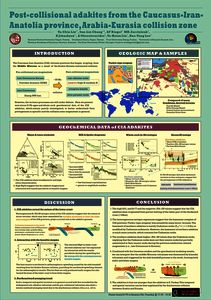Lin, Yu-Chin და Chung, Sun-Lin და i Bingol, Feyzi და Okrostsvaridze, Avtandil და Ghazar Galoyan, Ghazar და Lin, Te-Hsien და Lee, Yang (2017) Post-collisional adakites from the Caucasus-Iran-Anatolia volcanic province, Arabia-Eurasia collision zone. In: International Conference Goldschmidt 2017, 2017, Paris, France.
![[img]](http://eprints.iliauni.edu.ge/7348/1.hassmallThumbnailVersion/CIA%20Adacites%20Goldsch.2017.jpeg)
|
გამოსახულება
CIA Adacites Goldsch.2017.jpeg Download (1MB) | გადახედვა |
რეზიუმე
The Caucasus-Iran-Anatolia(CIA)volcanic province that began erupting from the Middle Miocene as a result of the Arabia-Eurasia collision consists dominantly of calc-alkaline rocks, with adakites, intraplate basalts and ultra-potassic rocks in localities. Here we present new zircon U-Pb ages and whole-rock geochemical data of the CIA adakites, which remain poorly investigated, to better understandtheir petrogenesis in specific and the collision zone magmatism in general. The CIA adakites are of and esitic to rhyolitic composition (SiO2=55-71 wt.%) and show high Sr/Y=24-125 and La/Yb(n)=13-52, typical of adakitic geochemical features. Their occurrence shows a systematic variation in time and space, first erupting from the south in Ulukale, SE Turkey (15.7-15.0 Ma),then propagating northeastward to Dehgolan, NW Iran(9.5Ma),Dumlu, E Turkey (8.5-5.6 Ma), Goderdzi, S Georgia-NE Turkey (8.0-7.4 Ma), and Sahand (6.5-4.3 Ma), NW Iran, and further to S Georgia-N Armenia (4.4-1.6 Ma), Sabalan, NW Iran (1.9-0.4 Ma) and Ghorveh, NW Iran (<0.5 Ma). Such a temporal and spatial variation is in general accord with that recorded by the widespread calc-alkaline volcanism. The CIA adakites as a whole show heterogeneous Sr-Nd-Hf isotopic ratios, for example, with those from south showing lower or negativeNd values [-6 to -2] and those from north showing higheror positive Ndvalues [+2 to +4], suggesting that the nature of micro-terrains, which may have assembled by multiple accretions to form the basement complex of the CIA province, plays a crucial role in the adakitic genesis. Our geochemical data support neither slab melting nor fractional crystallization,but suggest partial melting of the mafic lower part of thickened crust (≧45 km) that was present in localities for the generation of the adakites. The heat source is attributed to asthenospheric upwelling caused by the lithospheric delamination or slab break off resulting from the Arabia-Eurasia collision, a process that also led to generation of the calc-alkaline volcanic rocks and intraplate basalts from the Middle Miocene in the region.
| ობიექტის ტიპი: | სემინარის ან კონფერენციის მოხსენება (პლაკატი) |
|---|---|
| თემატიკა: | Q Science > QE Geology |
| განმათავსებელი მომხმარებელი: | ავთანდილ ოქროსცვარიძე |
| განთავსების თარიღი: | 01 დეკემბერი 2017 08:23 |
| ბოლო ცვლილება: | 01 დეკემბერი 2017 08:23 |
| URI: | http://eprints.iliauni.edu.ge/id/eprint/7348 |
Actions (login required)
 |
ობიექტის ნახვა |




